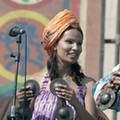Moroccan cuisine is a spectacle of delicious, colorful, and joyful food and dishes. From couscous to vegetable-loaded tajines and pigeon-filled pastillas, it embodies centuries of culinary know-how but also reflects times of hardship.
One chapter of Moroccan food tells a story of suffering, resilience, and survival, with many dishes invented during periods of natural calamities, epidemics, storms, floods, devastating locust swarms, and famine.
Morocco has experienced waves of locust invasions over the centuries, with swarms devouring crops and leaving many famished. But our ancestors found a solution—killing the invading insects and feeding hungry stomachs. It is no secret that Moroccans not only developed ways to consume the flying insects for survival but also turned them into a delicacy.
In this article, Yabiladi explores how Moroccans cooked locusts and integrated them into their diet during times of crisis.
Boiled, fried, salted and peppered
Moroccans preferred their locusts boiled first, according to historical accounts of foreign diplomats and writers in Morocco during the 18th and 19th centuries. «The poor used to devour boiled locusts with some salt and pepper», wrote Moroccan historian Mohamed al-Bazzaz in his detailed account of hunger and epidemic crises in 18th- and 19th-century Morocco, quoting British Consul General Drummond Hay.
Others reported that after boiling the little beasts, Moroccans liked to fry them for a crunchier bite. According to James Grey Jackson, a British merchant who lived in Mogador in the late 18th and early 19th centuries, dishes of locusts were «served up at principal repasts» during the summer of 1799 and the spring of 1800, which were marked by a plague that had «almost depopulated Barbary (an old name for Morocco)».

Moroccans cooked them as follows: «They were usually boiled in water for half an hour, then sprinkled with salt and pepper and fried, with a little vinegar added». They tasted like prawns, Jackson reported. The British merchant recounted that people would eat hundreds of them in one serving «without any ill effects». But for the poor who had to survive entirely on boiled and fried locusts, they became «emaciated and indolent».
Vengeful cooking
Some skipped the boiling phase and fried the flying insects in a rather vengeful manner. American captain James Riley, whose ship wrecked off Morocco in 1815 and who was later enslaved, recalled in his memoirs how locusts were considered «very good food by Moors, Arabs, and Jews».
Riley described how Moroccans cooked the locusts: «They catch large numbers of them in their season and throw them, while alive and jumping, into a pan of boiling argan oil». The insects «hiss and fry until their wings are burned off and their bodies are sufficiently cooked». Then they are finally poured out and served, wrote Riley, who compared their consistency and flavor to the «yolk of hard-boiled eggs».
According to historical records, some Moroccans mixed locusts with milk. In his book Insects as Human Food: A Chapter of the Ecology of Man, entomologist Friedrich Simon Bodenheimer reported that in North Africa, locusts, «fresh or preserved, with legs, wings, and heads removed», were grilled, boiled, or even prepared with couscous.

Some even dried them under the sun on rooftops, ground them into powder, and «mixed [them] with milk» or «kneaded [them] with flour and boiled with fat or butter and salt».
Quoting 18th-century French Dominican priest Jean-Baptiste Labat, Bodenheimer wrote that the «Moors take revenge on locusts by eating them». «They collect them carefully, put them into leather bags, pound them, and boil them in milk», he explained.
In some parts of Morocco, locusts were eaten smoked, as 18th-century French Consul Louis de Chenier described. He recalled that «smoked locusts are brought in prodigious quantities into the markets in Morocco», though they had «an oily and rancid taste which habit only can render agreeable».
Other ways of consuming the little insects included roasting, grilling, or cooking them in earth ovens, which still exist in Souss villages today.
The Moroccan-Jewish way
Moroccan Jews were no exception when it came to eating locusts. Bodenheimer mentioned that Moroccan Jews only ate female locusts, believing that «the males are unclean» and that «underneath the body of the females, there are some Hebrew characters which make them lawful».
They also had their own slow-paced cooking method. They would «salt them and keep them for use with the dish called Dafina, which forms the Saturday’s dinner for the Jewish population».
.jpg)
The dish is prepared by layering meat, fish, eggs, tomatoes, and various other ingredients in a jar, which is then placed in the oven on Friday night. It remains there until the Sabbath, ensuring a hot meal without violating the religious prohibition against lighting a fire on that day.
Sahara’s longest cooking process
In the Sahara, Moroccans had the most elaborate method of cooking locusts. Archibald Robbins, an American sailor shipwrecked off the coast of Morocco in the early 19th century and later captured by Saharan nomads, described the process in detail.
«They prepare them for food by digging a deep hole in the ground, building a fire at the bottom, and filling it with wood. When the soil is heated as much as possible and the coals and embers have been removed, they prepare to fill the cavity with live locusts, which have been kept in a bag holding about five bushels (equivalent to 36.4 litres)», Robbins recounted. The locusts were dumped into the heated pit, quickly covered with sand to prevent escape, and roasted under a second fire.
After cooling, they were dried in the sun for several days, then ground into powder or eaten whole after removing the head, wings, and legs. Robbins, who tasted them, considered them «nourishing food».
Moroccans succeeded in turning their enemy into food, overcoming food crises. In fact, the abundance of locusts as a food source led to temporary economic relief in food markets. Foreign travelers and diplomats reported that eating locusts and cooking them in innovative ways reduced demand for ordinary food supplies, leading to a decrease in the price of provisions.





 chargement...
chargement...













